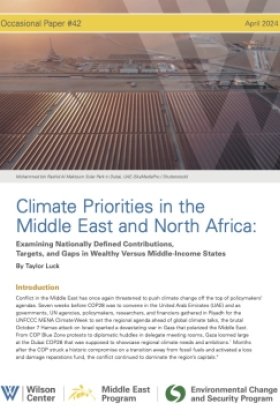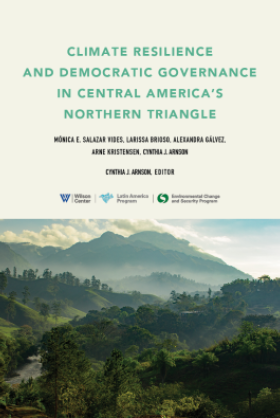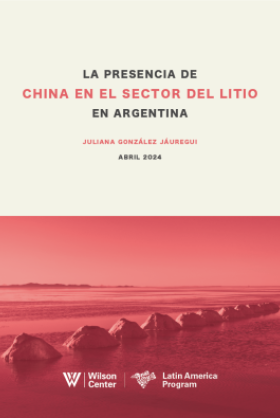Integrated Development in Population, Health, and Environment: Updates From Ethiopia and the Philippines
Ethiopia and the Philippines are leading the way in demonstrating how this promising integrated approach can both improve community health and encourage environmental conservation. Field-based personnel from Ethiopia and the Philippines discussed the opportunities and challenges they have faced on the ground and share best practices across sectors-and across continents.
Overview
"All protected areas in Ethiopia are being threatened by population pressure," said Negash Teklu, executive director of PHE Ethiopia at an event at the Woodrow Wilson Center co-sponsored by the Environmental Change and Security Program and the Africa Program. The best way to address this pressure is by implementing integrated population, health, and environment (PHE) programs that combine natural resource management with family planning services, said Teklu. "Without the family planning component, they cannot solve the protected area problems," he said.
 Teklu was joined by Joan Regina Castro, executive vice president at PATH Foundation Philippines, Inc., and Annie Wallace, PHE technical advisor with the USAID Global Health Fellows Program, to compare PHE projects in Ethiopia and the Philippines and identify best practices.
Teklu was joined by Joan Regina Castro, executive vice president at PATH Foundation Philippines, Inc., and Annie Wallace, PHE technical advisor with the USAID Global Health Fellows Program, to compare PHE projects in Ethiopia and the Philippines and identify best practices.
The Population-Climate Connection
To address population growth in areas of high biodiversity, Teklu created PHE Ethiopia, a consortium to coordinate PHE projects in the country and increase awareness of the value added by integrating them.
"The population-climate connection is easily seen in Ethiopia," said Teklu. The country's deforestation, loss of biodiversity, poverty, high maternal and child mortality, and vulnerability to climate change are linked to the rapid growth of its population, which is currently 85 million. Building community resilience in this kind of environment is "critical," he said.
Bridging Gaps: Gender, Youth, and Religion
 Wallace, in her assessment of the Packard Foundations' PHE projects in Ethiopia, found the projects bridged gender gaps. By integrating health and environmental education in PHE youth groups and in outreach by extension workers, the projects increased male involvement in health and family planning (a traditionally female activity) and increased women's involvement in agriculture and environmental activities (traditionally male). This cross-gender success increased the total number of family planning users, said Wallace.
Wallace, in her assessment of the Packard Foundations' PHE projects in Ethiopia, found the projects bridged gender gaps. By integrating health and environmental education in PHE youth groups and in outreach by extension workers, the projects increased male involvement in health and family planning (a traditionally female activity) and increased women's involvement in agriculture and environmental activities (traditionally male). This cross-gender success increased the total number of family planning users, said Wallace.
But for any of this work to succeed, "community ownership and participation are very critical and essential," said Teklu. Both youth and religious leaders were primary stakeholders in this process. "Youth are the next leaders. By targeting youth you can get them to think about livelihoods and make these connections," said Wallace.
PHE has proven to "transcend religion," said Castro. Despite traditional opposition to abortion and family planning, support from Christian and Islamic leaders in Ethiopia and the Philippines was critical in determining a project's success. "When religious leader buy-in comes in, the community really responds to that," said Wallace.
In addition, religious leaders understand the population–environment connection. "Our livelihoods are affected when we have too many mouths to feed…family planning and reproductive health makes sense," an Ethiopian religious leader told Wallace.
Securing Sustainable Support for Scaling Up
 IPOPCORM, the PHE initiative in the Philippines, is now "the biggest [PHE] project, modesty aside, in the world," said Castro, because it has succeeded in working at all levels of government. To scale up its work in the "priority areas" of high biodiversity and rapid population growth, where the "poorest of the poor" live, IPOPCORM first scaled up its advocacy work. To be sustainable, "you have to have a lot of PHE leaders and champions" at all levels, from village to national government, she said.
IPOPCORM, the PHE initiative in the Philippines, is now "the biggest [PHE] project, modesty aside, in the world," said Castro, because it has succeeded in working at all levels of government. To scale up its work in the "priority areas" of high biodiversity and rapid population growth, where the "poorest of the poor" live, IPOPCORM first scaled up its advocacy work. To be sustainable, "you have to have a lot of PHE leaders and champions" at all levels, from village to national government, she said.
Ethiopia faces a significant challenge in securing sustainable support and funding from the national government and other sources. "While there is buy-in for the local approach, there isn't funding," Wallace said. "A lot of work is donor-driven, whether we like it or not," she added. "There needs to be a more sustainable strategy" to ensure the survival of these projects, she said, which means garnering national and international support.
But it also means conducting research to provide empirical evidence of PHE's added value, the speakers agreed. A new paper in the journal Environmental Conservation, coauthored by Castro, uses evidence from IPOPCORM's projects to conclude that integrating family planning and coastal resource management offers benefits over single-sector approaches. But elsewhere, there is a "big need for monitoring and evaluation" to "strongly gather data to show our success on the ground," said Teklu.
However, communities on the ground "don't need the empirical evidence," said Castro. "The community and the people say their lives are linked and so the solutions should be linked," she said. "The life that they live speaks of integration."
Drafted by Hannah Marqusee and edited by Meaghan Parker
Geoff Dabelko, Environmental Change & Security Program, 202-691-4178
Documents & Downloads
- Integrated Development in Population, Health, and Environment: Updates From Ethiopia and the PhilippinesDownload
- Integrated Development in Population, Health, and Environment: Updates From Ethiopia and the PhilippinesDownload
- Integrated Development in Population, Health, and Environment: Updates From Ethiopia and the PhilippinesDownload
- Integrated Development in Population, Health, and Environment: Updates From Ethiopia and the PhilippinesDownload
- Integrated Development in Population, Health, and Environment: Updates From Ethiopia and the PhilippinesDownload
- Integrated Development in Population, Health, and Environment: Updates From Ethiopia and the PhilippinesDownload
- Integrated Development in Population, Health, and Environment: Updates From Ethiopia and the PhilippinesDownload
- Integrated Development in Population, Health, and Environment: Updates From Ethiopia and the PhilippinesDownload
Speakers
Hosted By

Environmental Change and Security Program
The Environmental Change and Security Program (ECSP) explores the connections between environmental change, health, and population dynamics and their links to conflict, human insecurity, and foreign policy. Read more
Thank you for your interest in this event. Please send any feedback or questions to our Events staff.








